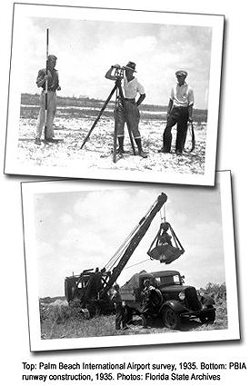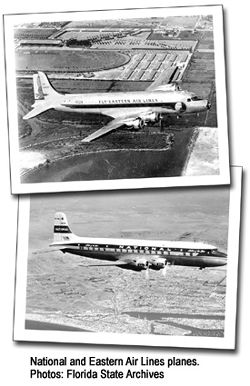History
 The Palm Beach County Department of Airports operates and maintains the Palm Beach International Airport (PBIA), the Palm Beach Park Airport in Lantana, Palm Beach County Glades Airport in Pahokee and the North County Airport on the Bee Line Highway - north of PGA Boulevard. PBIA is the center for all commercial air carrier service into Palm Beach County. The Lantana Airport and North County Airport are general aviation airports serving private and corporate airplanes. The Glades Airport serves the general aviation needs of the Glades region.
The Palm Beach County Department of Airports operates and maintains the Palm Beach International Airport (PBIA), the Palm Beach Park Airport in Lantana, Palm Beach County Glades Airport in Pahokee and the North County Airport on the Bee Line Highway - north of PGA Boulevard. PBIA is the center for all commercial air carrier service into Palm Beach County. The Lantana Airport and North County Airport are general aviation airports serving private and corporate airplanes. The Glades Airport serves the general aviation needs of the Glades region.
Commercially, PBIA had its beginning in 1936 when it was known as Morrison Field. It was named for Miss Grace K. Morrison, who was a pioneer in the early planning and organizing which culminated in the establishment of the field. The inaugural airline flight was made by a New York bound Eastern Air Lines DC-2 in 1936. Eastern's daily northbound flights departed in Miami, landed at West Palm Beach and 11 other cities and arrived in New York 13 1/2 hours after leaving Morrison Field. The field was officially dedicated and opened on December 19, 1936 with nothing more than the strip itself and a small administration building.
Palm Beach Aero Corporation obtained a five year lease in January 1937 for a hangar site and fixed base operational privileges. The first hangar, along with ramps and facilities was ready for use by flights at a small building on the south side of the airport, which became known as the Eastern Air Lines Terminal.
The outbreak of World War II in Europe caused the United States to quietly begin a massive defense build-up. In November 1940, the U.S. Army Air Corps began converting Morrison Field for military purposes and activated it for military use in 1941. Scheduled commercial service and private planes were relocated to the new Lantana Airport, six miles south. A month after Pearl Harbor, when the allied nations built up forces to invade France, Morrison Field processed 6,200 planes and 45,000 fliers. Many of them took off from Morrison Field for the D-Day invasion of Normandy.
In 1947, the operations of the Air Transport Command were transferred to Mobile, Alabama, and Morrison Field was deactivated on June 30, 1947. In September, the County took over the two-story Air Force operations building on the north side of the airport for use as a passenger terminal.
In 1948, the County decided that for long-term business and tourism growth, it should capitalize on the value of an internationally known name such as Palm Beach. On August 11, the Board of County Commissioners voted to officially change the name from Morrison Field to Palm Beach International Airport.
 For the next four years, the airport operated as a civilian airport. But in September, 1951, during the Korean War, the Air Force reactivated Morrison Air Force Base. Civilian operations and the passenger terminal were once again relocated to the south side of the field, first in a hangar and then in an adjacent building.
For the next four years, the airport operated as a civilian airport. But in September, 1951, during the Korean War, the Air Force reactivated Morrison Air Force Base. Civilian operations and the passenger terminal were once again relocated to the south side of the field, first in a hangar and then in an adjacent building.
Nearly 23,000 airmen trained in West Palm Beach during the Korean conflict. After the war, and after several years of fighting the federal government's move to the make the airport a permanent military base, the County took over airport operations in 1959.
Throughout the 1940's, only Eastern Air Lines and National served West Palm Beach. Starting in 1950, Bahamas Air operated out of PBIA. "Q" Airways came on the scene in 1952. Mackey arrived in 1953 and Riddle operated for air freight only in 1955. Capital came in for one year, 1954. Delta Air Lines started DC-7 service in 1960, followed a year later by United.
 In the 1950's, passengers left PBIA through the County's first permanent terminal located on Southern Boulevard. The terminal cost nearly $125,000 to build and was demolished in 1991.
In the 1950's, passengers left PBIA through the County's first permanent terminal located on Southern Boulevard. The terminal cost nearly $125,000 to build and was demolished in 1991.
In 1960, the 2,000 acres at PBIA were officially transferred to the ownership of Palm Beach County. During that time, Palm Beach County's needs were rapidly outgrowing the aging facility. President John F. Kennedy's frequent arrivals on Air Force One at PBIA also focused attention on the airport. Although there was a controversy over the issue of relocating the airport because of expansion needs, the general election of November 1963 proved that the voters did not want the airport moved. Plans for expansion began instead and in 1965, a $4 million bond issue funded the construction of the maintenance terminal and surrounding facilities.
On October 29, 1966, the main terminal at PBIA was dedicated. Federal officials later built a new air traffic control tower at the facility. In 1974, Delta Air Lines constructed the airport's second main terminal.
On October 23, 1988, the David McCampbell Terminal, named for World War II naval flying ace, Medal of Honor winner and Palm Beach County resident David McCampbell, was officially dedicated. Funded with about $150 million in revenue bonds, it has twice the number of gates (25), and potential for 24 more. The 600,000 square feet terminal includes a two story concession mall, which runs the entire length of the building. It is designed in the tradition of Palm Beach architect Addison Mizner, using keystone walls and porticos.